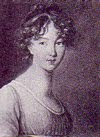
Katherine Bigelow (Mrs. Abbott Lawrence) (1855)
Chester Harding
(1792-1866)
American
Oil on canvas
(27 3/8” x 22 3/8”)
61.240
Museum of Fine Arts,
Boston, Massachusetts
Gift of the Misses Aimee and Rosamond Lamb
Thanks to one of my favourite blogs, 19th century American Women (http://b-womeninamericanhistory19.blogspot.com/ ), I found this wonderful portrait with one of the largest pieces of knitting I have ever seen in a painting. By clicking on the following link, readers can zoom in on the knitting, work basket, etc.:
http://www.mfa.org/collections/object/mrs-abbott-lawrence-katherine-bigelow-33681
What is Mrs. Lawrence knitting on two needles, flat/back and forth? She might be knitting something of her own design but she would, by the date given to the painting, 1855, have had access to numerous patterns for capes, shawls, lap rugs, counterpanes, pelisses, nubias, spencers, chest protectors, and hoods, perhaps one similar to the two I have featured on this blog. The copyright protection of printed materials was often difficult to enforce at this time and patterns were ruthlessly purloined and reprinted, sometimes with the audacious addition of the word “new” to the name.
The Illuminated Ladies’ Book of Useful and Ornamental Needlework by Mrs. Henry Owen (1844) contains a pattern for an Opera Hood, knitted in “Two-thread fleecy or double German wool” on “No. 3 needles” (6mm/10 US) With “ninety stitches,” knit in “rows of any light open pattern” (with a suggested pattern.) This hood is not a long piece but the pattern illustrates several clues to the knitting in the painting. Fleecy wool was a thin, fingering weight as was German wool, the latter also being used for Berlin needlework. The range of dyes or colour selection was enormous. One of my favourite examples of choice at this time is a pattern from Mrs. Cornelia Mee’s Exercises in Knitting (1846) in which knitted chair covers call for “Sixteen shades of scarlet, four-threaded German wool.”
Although I am always thrilled to see them, I don’t place much faith in accurate depictions of knitting in paintings as pieces of work range from fairly recognizable stockings (which could have been “modeled” by an independent piece of clothing that had nothing to do with what was on the needles or in the sitter’s hands) to a hazy group of brush strokes depending on the style of painting. This piece of knitting almost looks lacy or airy and is being knitted with two strands of wool seen emerging from the sweet little delicate basket with the interesting base, located on the floor beside the sitter. Is the darker wool, passed under the knitting, being used for a border, on the sitter’s left side, and the lighter shade for the body of the object?
If this is an accurate rendition, the wool is wrapped around Mrs. Lawrence’s right forefinger – a clue to her style of knitting? One of the “English” methods of knitting, the way I knit, in fact, although I use my middle finger to wrap and flick the wool. Mrs. Lawrence’s right hand is, however, too high, to be in the action of knitting; rather, she looks as though she has been interrupted, as so many knitters in paintings have been, and her right hand is arched above the right needle.
The needle on view is wonderfully thin but since its end is hidden by Mrs. Lawrence’s full sleeve, we cannot see if the needle is double-pointed or has a knob or flat end. This is odd if she is indeed knitting one of those airy items mentioned above as they are usually knit on rather large needles in contrast to the suggested thin wool or cotton in order to create the lacy effect.
Painted with her knitting in her hands, seated on a fashionable Gothic Revival chair beside a table covered with books and what may be her correspondence, and lovely fresh flowers, (perhaps from her garden?) as well as the bucolic view beyond the curtain we see a woman who is devout (the cross), elegantly but modestly dressed and an industrious member of a comfortable level of her society. To find out more about Mrs. Lawrence, go to http://bigelowsociety.com/rod/kat69521.htm
As always, I walk away from this kind of painting with new information but many more questions, too.


3 comments:
Could she be counting stitches? In which case, her obvious annoyance is understandable. The little knitting basket looks like a parody of a small dog, with four "legs," the mouth open and a red tongue visible.
Thank you for posting this painting. It is really interesting with all the details you have noticed.
Wonderful suggestions about the basket! Yes, she could be counting stitches (the position of the hand) - good idea!
Thanks for your comments, Tamar and Mette!
Post a Comment